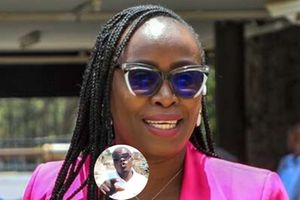Celebrating East Africa pioneer artists

Lady Magdalene Odundo after accepting the Order of the British Empire (OBE) from the Queen of England for her outstanding ceramic work, with her son Marimba, a champion runner in the UK. PHOTO | COURTESY
What you need to know:
- Magdalene Odundo left Kenya decades ago and established herself in the UK as one of the world’s leading ceramicists. Recently, Magdalene was awarded an Order of the British Empire (OBE) by the Queen of England for her work — the only Kenyan to receive such an honour.
- The dean of all East African artists, Francis Nnaggenda, whose monumental sculptures can be seen around Nairobi — including the iconic Mother and Child in front of the National Museums of Kenya – was forced to leave East Africa in the l970s for lack of buyers.
It is autumn now for the East African artists who started their careers just after independence in the 1960s and 1970s, at a time when Joseph Murumbi, the country’s second vice president and most prominent cultural collector, was their most important local patron.
During the past two years, several pioneer artists have been participating in a series of exhibitions at the Nairobi Gallery, reflecting the works in the Murumbi African Heritage Collections that are housed there. Most of these senior artists can brag about their storied accomplishments over nearly a half century.
Yet some of them — especially those who have chosen to remain in Africa — still live in borderline poverty. Their many accomplishments have not changed their daily lives nor brought them economic salvation, and they often find it necessary to subsidise their art from other sources of income.
The most successful among them have left East Africa to seek success abroad.
Magdalene Odundo left Kenya decades ago and established herself in the UK as one of the world’s leading ceramicists. Her astounding clay pots, or “vessels” as she prefers to call them, sell for astronomical amounts at auctions, several hundred times the prices at her first exhibition held at African Heritage during the United Nations Decade of Women’s Conference in Nairobi in 1985. Recently, Magdalene was awarded an Order of the British Empire (OBE) by the Queen of England for her work — the only Kenyan to receive such an honour.
OUTSTANDING MASTERPIECES
The dean of all East African artists, Francis Nnaggenda, whose monumental sculptures can be seen around Nairobi — including the iconic Mother and Child in front of the National Museums of Kenya – was forced to leave East Africa in the l970s for lack of buyers.
Murumbi had purchased five monumental sculptures by Nnaggenda but no other African had bought one. Nnaggenda then moved to Texas, US, where he lived for a quarter of a century before returning to be Chairman of Fine Arts at Uganda’s Makerere University.
The pioneer artists who have remained in East Africa tell a different story. They have had to subsidise their art with other skills and sources.
Sanaa Gateja, who set up a gallery in the Old Town of Mombasa in 1970 at the age of 19, finally returned to Uganda where he became known as the “bead king”, training dozens of women in the art of making recycled paper beads which he then incorporates into his art works on barkcloth, as well as creating utilitarian items like handbags and placemats or elaborate costumes.
Elkana Ongesa held the opening exhibition at African Heritage in 1973 when he was a student at the University of Nairobi. His sculptures now stand at the United Nations in New York , at Coca-Cola Headquarters in the USA, in China, as well as the Murumbi Peace Memorial at Nairobi City Park and at the entrance to the US Embassy at Gigiri.
Last year, Elkana’s “Hands off our Elephants” sculpture was to be the centrepiece of Kenya’s historic exhibition at the Smithsonian Folklife Festival on the mall in Washington DC, but the sculpture never arrived in the US. It now stands, incomplete and forlorn, on the grounds of the National Museums. This statue was to be the pinnacle of Elkana’s career, and he had borrowed funds to finance his work. This experience has plunged Elkana into further debt and despair, deepened by his own serious medical problems and the recent loss of several close family members.
Expedito Mwebe has produced numerous art works around East Africa, including the imposing carved wooden panels in the Bambara Lounges at the Nairobi and Kampala Serena hotels. However, his outstanding masterwork is at the All African Council of Churches off Waiyaki Way in Nairobi, is one of the most important works by an East African artist.
As one enters the circular building, one is immediately awestruck with this grand edifice, nearly 12 feet high, comprised of 42 wooden panels arranged in a semi-circle that trace the history of Africa, not by painting, but engraved into wood.
After having viewed this mural, it is hard for the viewer to reconcile the fact that Expedito is living in poverty, faced with the monthly threat of eviction from his house — where the rains have ruined many of his treasured sketches — with no money to pay his medical bills. He desperately requires about Sh2 million to replace machines, tools and to buy materials so he can continue working. He is offering one of his legendary “carved paintings” to cover these costs.
DIVERSE WORKS
Another pioneer, Jak Katarikawe, has a world following of art historians who have fondly dubbed him “Africa’s (Marc) Chagall” after the legendary Russian-French artist. Jak is now facing old age, decrepit and almost immobile, with memories of the resounding acclaim for his many exhibitions around the world. The self-taught Jak never learned to read or write, so he has often been taken advantage of by unscrupulous associates around him, especially when his paintings were selling in the millions.
At the time of this writing, Jak was appealing for well-wishers to provide funds to stave off starvation.
And finally, one of Africa’s most prolific artists, who taught sculpture to many of the country’s younger artists while he was artist-in-resident at African Heritage on Kenyatta Avenue, John Odochameny, now resides in Malaba in Uganda. His iron works are well known throughout East Africa, yet he has a difficult time surviving in today’s market. As from October 20, John’s metal sculptures share the small space for Pioneer Artists at the Nairobi Gallery with oil paintings by Peter Elungat, one of the most successful of a younger generation of artists.
As Africa’s greatest cultural collector, Murumbi urged hotels in East AFrica to collect and display the works of these early artists. With the exception of Serena Hotels, few have done so. Murumbi also suggested that private companies should devote a small percentage of their profits to support these artists as there is no safety net to help them when they run aground.
Now there is a proposal from American University in Washington DC to honour Murumbi by bringing together the diverse works of these first artists of East Africa in a nation-wide tour of the United States.
As the proposal states, “This is long overdue. It would be a wonderful vehicle to promote tourism to East Africa as well as to show the art and culture of this region to the USA and the world.”
Funds are being sought from US and Kenyan companies to support this endeavour. American University will administer the exhibitions and pay 40 per cent of the costs.
The Murumbi Trust and the National Museums of Kenya are encouraging US and Kenyan companies to support these senior artists as a good investment.
CFC Stanbic Bank has funded needed infrastructure at Nairobi Gallery, and Ford Foundation has contributed to events and supported the publication of A Path Not Taken, the story of Joseph Murumbi”, which was launched recently at the gallery.
The exhibitions by pioneer artists will continue throughout the year at the Nairobi Gallery.
Mr Donovan is the co-founder of African Heritage with Joseph and Sheila Murumbi and is now Chairman of the Murumbi Trust




